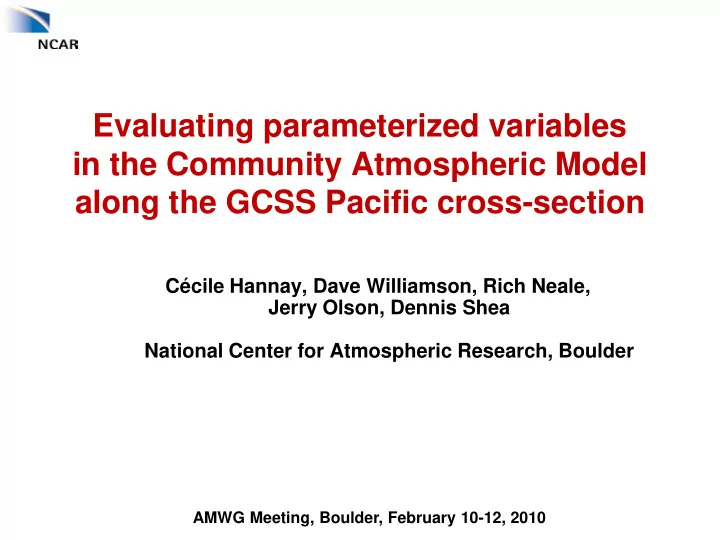

Evaluating parameterized variables in the Community Atmospheric Model along the GCSS Pacific cross-section Cécile Hannay, Dave Williamson, Rich Neale, Jerry Olson, Dennis Shea National Center for Atmospheric Research, Boulder AMWG Meeting, Boulder, February 10-12, 2010
The GCCS Pacific Cross-section Several cloud regimes: stratocumulus, transition, deep convection - EUROCS project JJA 1998 - GCSS intercomparison JJA 1998/2003 - This study YOTC: JJA 2008 - Observations ISCCP data SSM/I product CloudSat + Calipso GPCP and TRMM precip Flash Flux data - Reanalyses ERA-Interim, Merra
Observations along the cross-section Cloud fraction Low-level cloud CloudSat+Caliop ISCCP Precipitation LWCF SWCF __ TRMM ---- GPCP CERES-EBAF CERES-EBAF
Methodology for the forecasts Forecast • Strategy If the atmosphere is initialized realistically, the error comes from the Initialize realistically ECWMF analysis parameterizations deficiencies. • Advantages CAM - Evaluate the forecast against observations on a particular day and location - Evaluate the nature of moist 5-day forecast processes parameterization errors Starting daily at 00 UT before longer-time scale feedbacks develop. Evaluation • Limitations AIRS, ISCCP, TRMM, GPCP, SSMI, Accuracy of the atmospheric state ? CloudSat, Flash-Flux, ECWMF analyzes
Ensemble mean forecast and timeseries forecast Starting date Individual forecasts Ensemble mean forecast : average data at the same “forecast time” 7/3 7/2 1 2 3 Day of July Timeseries forecast : concatenate 7/1 data at the same “forecast time” (hours 0-24) from individual forecasts 0 1 2 3 Forecast time (days)
Model versions 3 versions of CAM CAM3 Release 2004 Release April 2010 CAM4 New physics: “track1” - Deep convection (Neale and Richter, 2008) Release June 2010 New Physics: - Cloud microphysics (Morrison, Gettelman) CAM5 - Radiative Transfer (Iacono, Collins, Conley) “track5” - PBL and Shallow convection (Bretherton and Park) - Macrophysics (Park, Bretherton, Rasch) - Aerosol formulation (Ghan, Liu, Easter) - Ice clouds (Gettelman, Liu, Park, Mitchell)
Highlights of the results • Climate bias appears very quickly in CAM - where deep convection is active, error is set within 1 day - 5-day errors are comparable to the mean climate errors • CAM3 - ITCZ: warm/wet bias of the upper troposphere too much precipitation and high level cloud - StCu: cloud too close to the coast and PBL too shallow • CAM4/Track 1 - ITCZ: CAM4 reduces warm/wet bias of the upper troposphere dramatic improvement of precipitation … but too little high-level cloud compared to observations • CAM5/Track 5 - ITCZ: same improvements as with CAM4 - StCu: better PBL height and low-level cloud fraction … but underestimates high-level cloud and LWP
Precipitation: Monthly means, June 2008 Forecast at day 5 Forecast at day 1 ____ TRMM Timeseries _ _ _ GPCP at the ICTZ ____ CAM3 ____ CAM4 ____ CAM5 • CAM3: overestimates the precipitation in the ITCZ • CAM4/5: reduction in the ITCZ precipitation at day 1 precipitation intensity increases later in the forecast
Precipitation timeseries, JJA 2008 Correlation with TRMM Precip Forecast at day 1 TRMM (mm/day) CAM3 (0.50) CAM4 (0.70) CAM5 (0.66) Days (JJA) Mixing parcel env At the ITCZ: No mixing • CAM3: overestimates the precipitation in the ITCZ rains all the time Allows mixing • CAM4/5: reduction in the ITCZ precipitation better correlation with observed precipitation underestimates strong events
Precipitation timeseries, JJA 2008 Correlation with TRMM Precip Forecast at day 1 TRMM (mm/day) CAM3 (0.50) CAM4 (0.70) CAM5 (0.66) Days (JJA) Pres (mbar) Relative humidity Days (JJA) CAM4/5: precipitation better connected to mid-troposphere
Precipitation timeseries, JJA 2008 Correlation with TRMM Precip Forecast at day 1 TRMM (mm/day) CAM3 (0.50) CAM4 (0.70) CAM5 (0.66) Forecast at day 5 TRMM CAM3 (0.19) CAM4 (0.47) CAM5 (0.46) Days (JJA) CAM4/5: correlation w/obs decreases in 5-day forecast
Moisture profile in the stratocumulus regime Moisture in CAM5 Moisture in CAM4 Day 0 Day 1 Day 3 Day 5 CAM5: PBL height is maintained CAM4: PBL collapses Dry and surface-driven scheme based on prognostic TKE PBL scheme w/ explicit entrainment at top of PBL
Water vapor budget in the stratocumulus regime ∂ q ∂ t = − V • ∇ q − ω ∂ q ∂ p + Q PBL + Q shallow + Q cloud − water Advective tendencies Total physics tendency: Q phys Q phys in CAM4 Q phys in CAM5 Total PBL shallow conv. cloud-water
Conclusion • CAM forecasts allows for diagnosing parameterization errors in different cloud regimes • CAM3 - too much precipitation near ITCZ (deep convection scheme: no mixing between the parcel and its environment) - PBL too shallow in StCu (dry and surface-driven PBL scheme ) • CAM4 - dramatic improvement of precipitation in the early forecast with the new convection scheme (entrainment of environment) • CAM5 - new PBL scheme produces deeper and better mixed PBLs (PBL scheme: prognostic TKE with explicit entrainment at top of PBL)
Recommend
More recommend